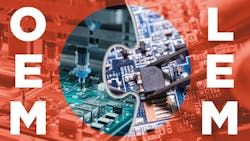The Original Legacy: A Partnership for Proactive Obsolescence Management
What you’ll learn:
- How LEMs and OEMs can team up to help customers with discontinued electronics.
- Why having a plan for old electronics is important and how working together makes everyone more resilient.
- 5 things embedded OEMs should avoid when dealing with old products.
While they share similarities, legacy equipment manufacturers (LEMs) and original equipment manufacturers (OEMs) are quite different. But these differences actually make them a great team. When they work together, LEMs and OEMs can best address the challenges of electronics obsolescence for their shared customers.
Embedded OEMs face a tough situation as their products get older. Customer demand continues, but their resources are already stretched thin with new projects. This creates a dilemma that puts them in a bind: Do they try to keep supporting old products with limited resources, or do they cut support entirely and risk letting down customers?
That's where LEMs come in. They're like OEMs, but instead of focusing on building new products, they specialize in keeping older products alive.
By teaming up with a LEM, OEMs can offload the burden of supporting older products. This frees up their resources to innovate and develop new products.
How OEMs and LEMs Fit Together
OEMs and LEMs are similar in that they engineer, manufacture, and repair embedded computer electronics. Both are outfitted with engineering, manufacturing, and production departments.
However, OEMs and LEMs have different missions and organize their teams' functions differently (Fig. 1).
OEMs make their money from new products. They're all about developing and launching new products quickly. Their focus is on winning contracts, high-volume production, and staying ahead of the curve with the latest technology.
LEMs, on the other hand, specialize in keeping old products alive. They rebuild the supply chain for discontinued products and ensure they continue to work as they always did. This often involves dealing with outdated technology and finding creative ways to keep things running.
The goal of a LEM is to sustain the product until the customer no longer needs it, providing replacement and repairs. This involves rebuilding the supply chain to support the product and making minimal changes to ensure parts remain form, fit, and functionally identical to the original design.
LEMs are well-versed not just in leading-edge sustainment techniques, but also in obsolete technology. Legacy products' architectures, standards, tools, and software are often at least a decade old.
>>Check out more articles in this series on product-lifecycle and obsolescence management.
OEMs and LEMs have very different goals. OEMs aren't equipped to handle the complexities of supporting old products, and LEMs aren't designed for new product development. But they can actually fit together like pieces of a puzzle. Such a partnership helps both companies and their customers by solving the challenges of product obsolescence while still allowing OEMs to innovate.
Combining Forces for Customer Satisfaction
OEMs and LEMs share the same goal—both want to profitably support their customers (Fig. 2).
Legacy products might seem old, but they're still crucial for many businesses. Some of our customers here at GDCA rely on their older embedded circuit cards for years and years. Upgrading can be a huge hassle—expensive, time-consuming, and sometimes it just doesn't work with their existing systems.
That's where partnering with a LEM really helps. The LEM takes on the responsibility of managing these legacy products, enabling the OEM to focus on developing exciting new ones. This is a win-win! OEMs can continue to provide the support their customers expect, and customers can be confident that they'll have the support they need for the long haul. This builds strong, lasting relationships between OEMs and their customers.
Collaborating for Enduring Success
LEMs aren't just helpful after a product is past its end of life. Some types of LEMs, like GDCA, offer lifecycle planning and sustainment services for future anticipated demand.
The earlier an embedded OEM begins to plan for when its products (or parts) will be discontinued, the more time it will have to devise a sustainable solution that will satisfy all stakeholders.
An LEM can help the OEM determine alternative support paths so that the transition of products from "current" to "obsolete" can be smooth when the product is discontinued. This is good for customer satisfaction and retention because customers can confidently continue getting the products and replacements required for their systems. It's also good for the OEM because they can move on to new product development and marketing without leaving legacy product customers behind.
What Embedded OEMs Should Avoid for Legacy Product Sustainment
Understanding legacy product sustainment starts with understanding the importance of legacy products to application OEMs and their end-user customers. Sustaining production for legacy computers isn't something that just anyone can do, and it's certainly not something companies should try to do alone.
Why not?
Legacy product sustainment is a process that requires collaboration throughout the supply chain (Fig. 3).
The following are five things embedded OEMs should avoid when dealing with legacy products, and some ways LEMs can provide innovative alternatives to these common pitfalls.
1. Don't rely too heavily on legacy products
An embedded OEM's future is new products. A healthy product portfolio has the right balance of new products, mature and high-running products, and legacy products.
It's not uncommon for these ratios to fall out of balance. Some companies become over-reliant on legacy product revenue.
For example, a healthy body needs some cholesterol, and a healthy product portfolio needs some legacy products. However, relying on legacy products for disproportionate overall revenue is often part of a long, slow slide to shrinking revenues. Why?
By definition, legacy products SHOULD have a lower remaining lifetime value than newer active products. If this isn’t the case, then there's a problem with the pace of new product introduction. Regardless, mature products' revenue will continue to fall after they hit their peak.
Besides the increasing difficulty of wringing out revenue over time, over-reliance on legacy products consumes disproportionately more resources than active products. It clogs up engineering and production resources to secure ever-diminishing returns.
In a sense, LEMs provide a clearinghouse for legacy designs, enabling embedded OEMs to keep their portfolios lean and profitable. Otherwise, the collective weight of legacy products undermines OEMs' agility and profitability.
2. Don't distract new product design engineers with sustainment projects
There are multiple reasons why assigning sustainment projects to new-product engineers is a bad idea. The main reason is that it takes resources away from projects with a MUCH better ROI.
Moreover, although they're based on older technology, legacy products can still be very complex. This means that the impact of fixing obsolescence issues on legacy designs isn’t isolated to a single engineer. They often need to consult with the original engineering team (if they're still around) and other support teams.
Another challenge in sustaining older legacy products is customer management. Typically, customer-facing teams must be engaged to secure design change approvals from the customer. If the change doesn't work as intended in the customer's application, a prolonged troubleshooting exercise is required to resolve the issue.
Finally, it's difficult for an engineer to do sustainment on someone else's design. So, embedded OEMs have the choice of assigning a junior engineer and risking cost and timeframe overruns or sacrificing the time of a more experienced and highly valued engineer who is familiar with the original design.
LEMs don't face this dilemma because their engineering teams are focused ONLY on solving electronics obsolescence and sustaining legacy products.
3. Don't buy too much inventory of obsolete components and hardware
Inventory is one of discontinued legacy systems' largest and most overlooked expenses.
It's typical for OEMs to secure last-time buys of electronics components so that they can unlock revenue from predicted future demand for finished products. But things don't always go as planned.
Unlike other direct expenses, the impact of pre-stocking obsolete inventory on overall company performance isn’t always immediately knowable or apparent. OEMs expect to eventually recover all inventory pre-stocking costs at the time of order.
Unfortunately, this mindset often doesn't account for the eventuality of inventory write-off expenses when the OEM overstocks. It's also typical for these write-offs NOT to be factored into the actual performance of legacy product orders, giving OEMs an inflated sense of the value of legacy products to them.
Many years ago, I worked with a client who had accumulated $10M in obsolete inventory on a product line that had peaked at $75M/year… but was now doing about $25M in sales and falling. This forecast was less than initially anticipated. I've seen this happen before and since.
Doing some quick math, their 20% net profit business would have to make $50M in sales just to recover the obsolete inventory expense. Unfortunately, the product only had a five-year sales total forecast of $45M.
In other words, it didn't make sense to continue manufacturing the legacy products, especially considering that more parts continue to become obsolete, adding to the overall pre-stocking inventory investment.
4. Don't twist customers' arms
New products are the lifeblood of a healthy business. When embedded OEMs introduce new products, they not only secure design wins for new products, but also provide an opportunity for existing customers to upgrade their existing applications—oftentimes offering enhancements to end-users.
In reality, some customers just prefer not to upgrade. Many times, it's because their application solutions are sufficient, at least for the time being. Or perhaps they simply don't have the funding to do an obsolescence-forced upgrade and rely on a steady supply of an OEM's legacy products.
Unfortunately, product discontinuation typically causes hardships for these legacy customers in the form of unbudgeted last-time-buy orders and technology upgrades/refreshes.
No one likes to be pressured into a situation that isn't beneficial for them, and customers have a long memory. When OEMs force customers to do things they don't like, it often undermines all goodwill and hard-won credibility.
On the other hand, when OEMs continue support in response to customer preferences, it often undermines their own profitability.
LEMs provide an innovative alternative to traditional legacy product approaches—helping embedded OEMs resolve the dilemma of choosing whether or not to protect customers or themselves.
5. Don't continue to manufacture legacy products after a last-time buy
At some point, whether or not they enable a LEM to continue manufacturing and repairing their legacy products, embedded OEMs must offer their customers a last-time buy.
The great jazz musician Thelonious Monk said, “There is no wrong note; it has to do with how you resolve it.” Last-time buys aren’t inherently bad; it's the next move that determines whether they're "wrong" or not.
Agreeing to do another "last-time-buy" for desperate customers encourages them to return again and again. It also undermines the original decision to discontinue less profitable and non-strategic products as well as OEMs' credibility.
Partnering with an LEM so that they can take over sustainment for discontinued products is a good way to make last-time buys into music—instead of noise.
Collaborating on Obsolescence for Sustainability
Providing support for legacy products can be rewarding, but going it alone or using old strategies that aren't advantageous, especially in the long run, can be extremely costly.
LEMs and OEMs may be entirely different manufacturers, but they are two sides of the same coin. When they work together, they can create a sustainable future for their embedded computing customers and themselves.
Obsolescence doesn't have to be something pushed off to the future, brushed aside until a customer is desperate for a discontinued product. Through the collaboration of legacy and original manufacturers, electronics obsolescence can become a natural part of the product lifecycle that both parties and their customers can benefit from.
Be proactive in developing legacy product sustainment strategies, and most importantly, don't try to go it alone. Collaboration is key to a successful strategy for obsolescence management and product sustainment.
>>Check out more articles in this series on product-lifecycle and obsolescence management.
About the Author
Ethan Plotkin
CEO
Ethan Plotkin is the CEO of GDCA Inc. (“Great Designs Continued Always”), who used his experience in supply-chain risk management (SCRM) to lead the company from its early days as a small OEM into becoming a trusted legacy equipment manufacturing partner for defense and related OEMs across the country. GDCA originally partnered with OEMs as a source for EOL or obsolete circuit boards, but found that they were just a surrogate for obsolescence in the supply chain.
Together with his team, Ethan built on his experience in SCRM to create a systematic approach to sustain and manufacture obsolete electronics—a much bigger mission that’s much more achievable. Under his management, GDCA has become an entirely new type of business—a legacy equipment manufacturer (LEM).
Ethan has also worked extensively with the National Defense Industry Association (NDIA) and currently leads the Supply Chain Network Committee, which facilitates collaboration between government, industry, and other NDIA divisions to strengthen National Security through industrial supply chains. His work in obsolescence management has brought a unique perspective to the many different factors that influence supply-chain challenges and how manufacturers can overcome them.





